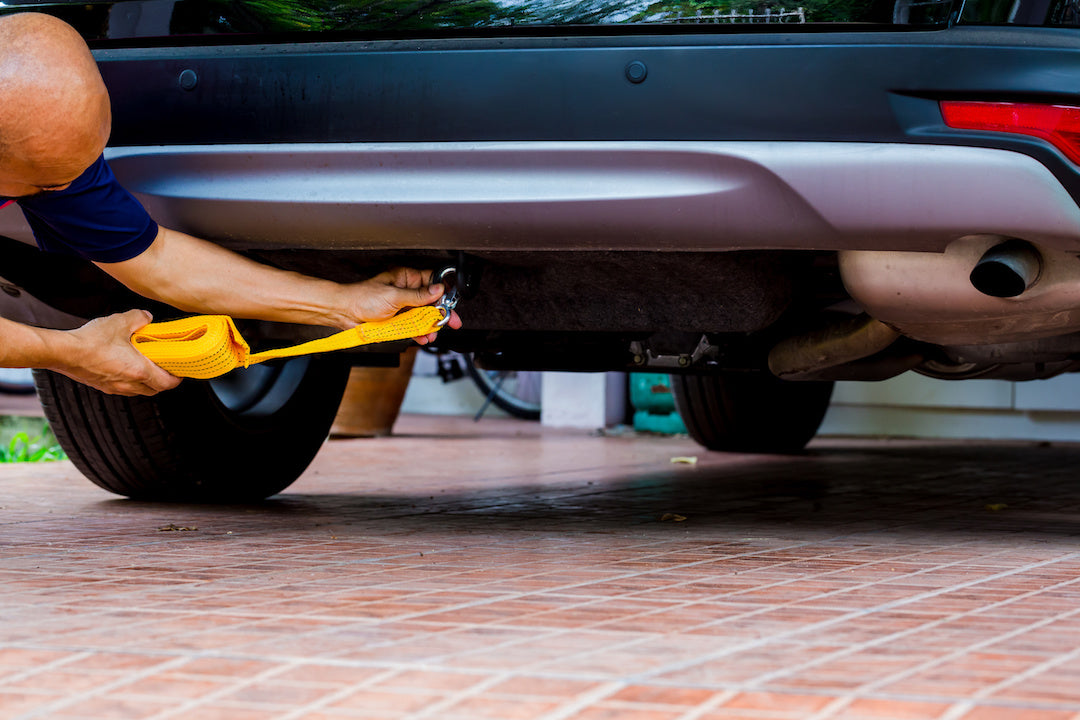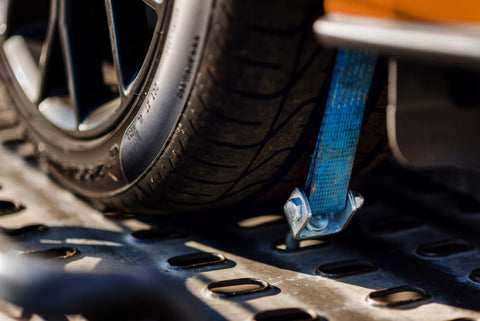
A Complete Guide to Vehicle Tiedown Straps for Beginners

You may be wondering how to secure a stuck vehicle to your vehicle or trailer without the risk of damage to any vehicle. Or, you may want to see what recovery equipment is right for your job. After all, a sudden stop, damaged tiedown, or lane change is the only thing between a safe delivery or destroyed cargo. Regardless of what you're hauling, having the right tiedowns is incredibly important to ensure your cargo is delivered safely.
Continue reading to learn the difference between recovery straps and tow straps, the various types of vehicle tiedowns, and how to use them.
What are Recovery and Tow Straps Made out of?

First, let’s learn what they are made out of so you can determine which tiedown is right for your job.
The most common materials used to make vehicle tiedowns are polyester webbing and nylon webbing. The difference is what you should be using in recovery and towing applications.
If you’re in the towing industry or tow a lot, we recommend using straps with polyester webbing. Our Ratchet Straps with RTJ Cluster Hooks are extremely useful because the cluster hook combines three hooks into one chainring, providing multiple options to securely tie down any vehicle. Tow Ratchet Straps are perfect for towing because they have minimal stretch to ensure a firm hold on your cargo.
For recovery operations or quick vehicle recoveries, we recommend using nylon straps. Our 1-Ply and 2-Ply Recovery Straps have high-quality nylon material that contains pliable webbing to conform and support the load. It also has CORDURA® loops (or “eyes”) on each end, providing more resistance to cutting than nylon fabric. This will work well with tow anchor shackles to offer a strong connection point with the ease of a quick-release pin.
Wait, What’s the Difference between Recovery and Tow Straps?
The main difference between a tow strap and a recovery strap is the fabric and their ability to stretch. The tow strap's polyester webbing stretches less than nylon, and simply tows a vehicle behind another.
You should not use tow straps to recover a stuck vehicle. They’re less flexible and are to pull a load that freely moves.
The purpose of a recovery tiedown is to “recover” a vehicle from a tight situation like mud, rain, etc. These tiedowns have loops on each end and you could use them for both towing and recovery operations. However, it’s important to take special precautions when using these straps for towing. The stretch can cause a bit of a rubber band effect, which can sling-shot the vehicle at uneven speeds.
Learn more about the differences between Recovery and Tow Straps.
How Do I Find a Tiedown that Safely Secures My Vehicle?

The answer is simple - you’ll want to start by finding the strap that fits the weight of your vehicle best. There are multiple ways to find your vehicle's weight. You can locate this through your owner's manual, a sticker on your driver's door, or even through a Google search.
Once you discover the weight of your vehicle, this can help you determine the Working Load Limit (WLL) and Break Strength (BS) of the tiedown you’ll need. In other words, the amount of weight that’s safely rated for your car tiedowns. A good rule of thumb is for the vehicle weight to be half the break strength of the tiedown.
Confused about what Working Load Limit and Break Strength mean? Read Working Load Limit, Breaking Strength & Safety Factor: What Do They Mean?
Then, you can determine which tiedown is right for the job whether it's for recovery or towing operations. Read below the different types of vehicle tiedowns.
Different Types of Car Tiedowns, or for Other Recovery Applications

While this isn't a complete list of vehicle tiedowns, these are common tiedowns to use for recovery and towing operations.
1-Ply Recovery Straps
Made with a single layer of high-quality industrial grade nylon material, 1-Ply Recovery Straps are useful for pulling vehicles out of a tight spot and are an essential tool for anyone to have in their vehicle.
2-Ply Recovery Straps
Made with two layers of high-quality industrial grade nylon material, 2-Ply Recovery Straps are stronger recovery straps than 1-Ply Recovery Straps. 1-Ply has a single layer of nylon material with a break strength of 16,000 – 96,000 lbs, while the 2-Ply has two layers of nylon material with a break strength of 96,000 – 128,000 lbs.
These are heavy equipment recovery ropes and are one of the best ways to get a vehicle out of tough situations like water, snow, mud, or other road debris
Tow Ratchet Straps with RTJ Cluster Hooks
Ratchet Straps with RTJ Cluster Hooks are perfect for towing cars and other vehicles. The strap has polyester webbing, having minimal stretch to ensure a firm hold on your cargo. The RTJ hooks give you a variety of options to securely tie down any vehicle.
The R Hook – Ford Vehicles
T Hook – GM and Chrysler Vehicles
J Hook – Foreign Vehicles (these have parts made and assembled outside the country)
Axle Straps
Axle Straps attach around the vehicle's axle to secure it to trailers of flatbeds for transit. This helps create a securement point to prevent your vehicle from moving or becoming unsecured. Axle straps are easy to use and are made with 12,000 lb. industrial-grade polyester webbing for maximum strength and durability.
Lasso Straps
Car haulers use Lasso Straps as a universal car tie-down strap. They’re especially convenient and often used when low clearance is a concern. When using a Lassp Strap, just thread the strap around the tire and secure it with a ratchet or winch.
Tree Saver Straps
Tree Saver Straps are great for protecting your winch cable and the tree from damage when freeing a vehicle from a stuck position. To use, you simply wrap the strap around your tree (or other anchor points) and lock your winch hook into the eyes of the strap. Our 3" x 6' Tree Saver Strap is made of durable 3" wide nylon webbing with a tensile strength of 30,000 lbs., so it's strong enough to pull vehicles rated 12,000 lbs. or less.
How to Use a Recovery Tow Strap

Choosing the right tiedown for your towing or recovery application is critical. As we mentioned earlier, finding out the weight of your vehicle first will help you determine what tiedown you'll need to use. Read the steps on how to use a recovery tow strap:
- Attach the strap to the rear of the towing vehicle, somewhere with plenty of structural support.
- Secure the strap to the stuck vehicle. If you need help locating the exact mount to place the hook, make sure to refer to the owner's manual.
- Once both hooks are secured, the drivers of both vehicles can get behind the wheel. The recovery vehicle can start accelerating slowly and gradually, straightening the strap to its full extent.
- The vehicle being recovered should be in gear, and once they're moving - the driver should apply some gas and steer their vehicle out.
- The recovery vehicle can continue at a slow, safe speed to the nearby destination.
If you're stuck in snow, learn How to Pull a Car out of Snow Using a Recovery Strap.
Helpful Hints for Using a Tow Recovery Strap:
Before you start using car hauler straps, make sure to keep these tips in mind.
- Always inspect towing and recovery straps for damage prior to use. If you’re new to this operation, stop every once in a while when driving to check your work and see if the strap is holding up well.
- When using tow straps, wrap around an appropriate frame point and thread the towing strap or snatch strap through the eye of the other end to choke the frame.
- For tow strap recovery use, always securely attach the hardware to the recovery vehicle. Our anchor shackles are great for recovery vehicles.
- Get rid of any debris or material that may cut or damage the tie down.
- When using a recovery strap, a good rule of thumb is for the vehicle weight to be half the break strength of the recovery strap.
- When choosing heavy-duty nylon recovery & tow straps, you should choose one that is strong enough, but not so strong that it won't stretch. It is essential for the recovery strap to stretch so the memory of the nylon webbing will help "snap" the vehicle out and take some of the shock out of the initial pull. This tow strap strength is important in knowing how to use recovery straps for the best results.
Getting You What you Want, When You Need it
Recovery straps and tow straps are invaluable pieces of equipment whether you are in the towing business and need a heavy tow strap, off-road recovery straps for recreational use, or truck tow straps for emergency situations.
If you have any questions about what strap is best for your application, or if you need a custom strap, call us at 800-969-6543 and we’ll be happy to help you.




